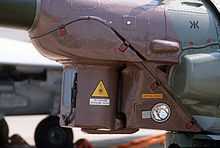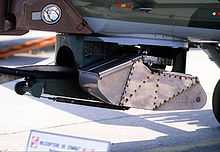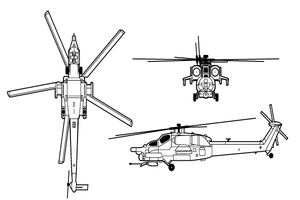Mil Mi-28
The Mil Mi-28 (NATO reporting name 'Havoc') is a Russian all-weather, day-night, military tandem, two-seat anti-armor attack helicopter. It is a dedicated attack helicopter with no intended secondary transport capability, better optimized than the Mil Mi-24 for the role. It carries a single gun in an undernose barbette, plus external loads carried on pylons beneath stub wings.
Development
Origins
In 1972, following completion of the Mil Mi-24, development began on a unique attack helicopter with transport capability. The new design had a reduced transport capability (3 troops instead of 8) and omitted the cabin, to provide better overall performance and higher top speed. Improved performance was important for its intended role fighting against tanks and enemy helicopters and covering helicopter landing operations. Initially, many different designs were considered, including an unconventional project with two main rotors, placed with engines on tips of wings (in perpendicular layout), and with an additional pusher propeller on the tail. In 1977, a preliminary design was chosen, in a classic single-rotor layout. It lost its similarity to the Mi-24, and even the canopies were smaller, with flat surfaces.
Design work on the Mi-28 began under Marat Tishchenko in 1980.[3] In 1981, a design and a mock-up were accepted. The prototype (no. 012) was first flown on 10 November 1982.[3] The second prototype (no. 022) was completed in 1983. In 1984, the Mi-28 completed the first stage of state trials, but in October 1984 the Soviet Air Force chose the more advanced Kamov Ka-50 as the new anti-tank helicopter. The Mi-28 development was continued, but given lower priority. In December 1987 Mi-28 production in Rosvertol in Rostov on Don was approved.

In January 1988 the first Mi-28A prototype (no. 032) flew. It was fitted with more powerful engines and an "X" type tail rotor instead of the three-blade version. The Mi-28A debuted at the Paris Air Show in June 1989. In 1991 the second Mi-28A (no. 042) was completed. The Mi-28A program was cancelled in 1993 because it was deemed uncompetitive with the Ka-50, and in particular, it was not all-weather capable.

The Mi-28N was unveiled in 1995, the N designation meaning "night". The prototype (no. 014) first flew on 14 November 1996. The most significant feature is a radar in a round cover above the main rotor, similar to that of the American AH-64D Apache Longbow. Mi-28N also has improved Tor vision and an aiming device under the nose, including a TV camera and FLIR. Due to funding problems, development was interrupted. A second prototype with an improved rotor design was unveiled in March 2004 at Rosvertol.
Changes in the military situation after the Cold War made specialized anti-tank helicopters less useful. The advantages of the Mi-28N, like all-weather action ability, lower cost, and similarity to the Mi-24, have become important. In 2003, the head of Russian Air Forces stated that the Mi-28N and Ka-50 attack helicopters will become the standard Russian attack helicopter.[4]

The first serial Mi-28N was delivered to the Army in 2006.[5][6] By 2015, 67 Mi-28Ns are planned to be purchased, when the Mi-24 is to be completely replaced.[6][7]
Mil also developed an export variant of the Mi-28N, designated Mi-28NE, and a simpler day helicopter variant, the Mi-28D, based on the Mi-28N design, but without radar and FLIR.
Mi-40
The Mil Mi-40 was a projected utility version of the Mi-28, first initiated in 1983, announced in 1992 and shown at the Moscow Airshow in 1993. It was primarily intended for the "Aerial Infantry Fighting Vehicle" category as a successor to the Mil Mi-24 and Mi-8 assault helicopters.
It was planned to use two 1,863 kW Klimov TV3-117 turboshaft engines, four-blade main rotor, four-blade Delta H tail rotor (both from the Mi-28), and retractable tricycle-type landing gear. It was expected to weigh 11-12,000 kg and estimated to attain a 3300 m ceiling, a 314 km/h maximum speed and a 260 km/h cruise speed.
Specifications required the functioning in day, night and poor weather as well as carrying eight soldiers (the design achieved seven in practice), eight stretchers or large external loads. An emphasis was placed on survivability with a focus on redundancy, IR suppression and special shock absorbers for the crew to increase the maximum "safe" crash velocity.
The design incorporated a 23 mm cannon (most likely GSh-23L) for defense in the forward hemisphere and a 12.7 mm machine gun (most likely Yak-B) for defense in the rear. Fuselage fairings containing fuel would replace stub wings with missiles mounted above on special hardpoints.
Its design borrowed much from the Mil Mi-36 developed over the previous two years, and would itself be replaced after a year by the Mil Mi-42 project. Although the Mi-40 design would be resurrected for a short period in the 1990s, with optimization studies being completed, it did not reach the prototype stage.
Mi-28NM
Russia will develop and test a prototype Mi-28 with 5th generation attack helicopter features by 2017. Called the Mi-28NM, it has been in development since 2008. Specific characteristics are not known, by may include a low radar signature, extended range, advanced weapons control systems, air-to-air engagement capability, and increased top speed of 600 km/h (370 mph).[8]
Design
The Mi-28 has two heavily armored cockpits, a windshield able to withstand hits from 12.7–14.5 mm caliber bullets, a nose equipped with electronics, and a narrow-X tail rotor (55 deg) with reduced noise characteristics. It is powered by two 2,200 hp Isotov TV-3-117VM (t/n 014) turboshaft engines.
While the Mi-28 is not intended for use as a transport, it does have a small passenger compartment capable of carrying three people. The planned purpose of this is to enable the rescue of downed helicopter crews.
The Mi-28N features a helmet mounted display for the pilot. The pilot would designate targets for the Navigator/Weapons Officer, who proceeds to fire the weapons required to fulfill that particular task.
Armament
The Mi-28 is equipped with a chin-mounted 30 mm Shipunov 2A42 autocannon. The cannon is select fire, and has a dual-feed, which allows for a cyclic rate of fire between 200 rounds per minute to 550 rounds per minute. Its effective range varies from 1500 meters for ground vehicles to 2,500 meters for air targets. Rounds from High Explosive Incendiary (HEI) to Armour-Piercing Discarding Sabot (APDS) can be used. Stated penetration for the 3UBR8 is 25 mm of RHA at 1,500 meters.
One common Mi-28 armament are a pair of 8 Ataka missile racks along with 2 B-13L rocket pods, each able to carry 5 S-13 rockets. Other rocket options include two B-8 rocket pods, each able to carry up to 20 S-8 rockets.
There are four variants of the Ataka missile for different tasks. The 9M120 Tandem High Explosive Anti-Tank (HEAT) warhead variant is used against tanks fitted with Explosive Reactive Armor (ERA), its penetrative ability is stated at 800 mm Rolled Homogeneous Armour (RHA).[9] The 9M120F Thermobaric variant is used against infantry, buildings, bunkers, and caves. The 9M120O expanding rod warhead variant is used against other helicopters. All the variants have a range of 6 km. The 9M120M improved version has a longer range (8 km) and better penetration (900 mm of RHA).[10] All of the variants use SACLOS missile guidance.
The S-8 and S-13 rockets used by the Mi-28 are usually unguided. In the most common configuration, one can expect 40 S-8 rockets or 10 S-13 rockets. Both rockets have their variants, from HEAT warheads to a Thermobaric warhead. The S-8 has a shorter range and smaller warhead than the S-13, but compensates with numbers. Currently, the Russian Air Force are upgrading their S-8 and S-13 rockets to laser guided[11] missiles with the proposed Ugroza ("Menace") system. Rockets upgraded under Ugroza would receive designations S-8Kor and S-13Kor, respectively.
Operational history
Russia
The Russian Army received the first Mi-28 prototypes for testing in 2004.[1] It received the first serial production Mi-28N in 2006,[5][6] which then joined two prototype helicopters for army trials. The aircraft entered service in 2006.[12] It has entered service under the name of "Night Hunter" (Russian: Ночной охотник).[citation needed] A squadron of Mi-28Ns from Torzhok took part in a joint army exercise in Belarus in June 2006.[citation needed]
The Russian Air Force had 24 Mi-28s in service in February 2011.[13] On 15 February 2011, a Mi-28 crashed in the southern Russian region of Stavropol. One of the pilots later died in the hospital.[14][15]
The Russian Defense Ministry will procure up to 60 Mi-28UB training versions by 2020. The version will speed up and improve pilot training. Four to six Mi-28UBs will be purchased for every unit that operates the Mi-28N. The Mi-28N is to replace the Mi-24 Hind in the Russian Armed Forces by 2015.[16]
Iraq
In October 2012, it was reported that Russia and Iraq may sign a $4.2–$5.0 billion weapons contract, including 30 Mi-28N helicopters.[17] The deal was confirmed on 9 October.[18] The deal was reportedly cancelled due to Iraqi concerns of corruption,[19] but that concern was addressed, and the Iraqi defense minister stated that "the deal is going ahead."[20][21] Despite early complications, all parts of the $4.2 billion contracts were signed, and are being executed. The first contract for 10 Mi-28NE helicopters for Iraq will begin delivery in September 2013.[22] A batch of 13 Mi-28NE helicopters was delivered in January 2014.[23]
Potential and future operators
The Indian Military asked for a modified prototype of Mi-28 fitted with French and Belgian avionics. Russian manufacturers were discussing how to meet these requirements.[24] In late October 2011, it was reported that the American AH-64D had emerged as the front-runner ahead of the Mi-28N to fill a requirement for 22 attack helicopters.[25][26]
In June 2010, Algeria was expected to place an order for 42 Mi-28NE helicopters.[27]
In April 2010, Venezuela agreed to order 10 Mi-28s for the Venezuelan Army.[28] But the contract may not have been signed.[citation needed]
Variants

- Mi-28 – Prototype version; first flight in 1982.
- Mi-28A – Original production anti-tank helicopter. Development done in 1998, first flight in 2003.
- Mi-28N/MMW Havoc – All weather day-night version. Equipped with a top-mounted millimeter-wave radar station, IR-TV, and a laser range finder. Powered by two Russian Klimov TV3-117V MA-SB3 engines (2,500 hp each), produced by the Ukrainian Motor-Sich. Max take off weight 11,500 kg, max payload 2,350 kg.
- Mi-28D – simplified daylight operation version. Similar to Mi-28N, but without top-mounted radar and FLIR.
- Mi-28NAe – export version offered to North Korea.[29]
- Mi-40 – Proposed armed transport version. Never reached prototype stage.
- Mi-28UB - Učebno-Bojevoj (Training-and-Combat) version, designed for training for Mi-28N. Has dual hydromechanical flight controls that can be operated from tandem cockpits, a more spacious lower cockpit to house a flight instructor, a wider pilot canopy, and new energy-absorbing crew seats. Serves as a trainer but can perform attack helicopter tasks.[30]
Operators
 Iraq
Iraq
- Iraqi Air Force (12 on firm order)[31]
 Kenya
Kenya
- Kenya Air Force - 5 in use as of 2013[32][33]
 Russia
Russia
Specifications (Mi-28N)

Data from Jane's[1]
General characteristics
- Crew: 1 pilot (rear), 1 navigator/weapons operator (front)
- Length: 17.01 m (55 ft 10 in)
- Rotor diameter: 17.20 m (56 ft 5 in)
- Height: 4.70 m (15 ft 5 in)
- Disc area: 232.35 m² (2,501 ft²)
- Empty weight: 8,600 kg (18,960 lb)
- Loaded weight: 10,700 kg (23,590 lb)
- Max. takeoff weight: 11,500 kg (25,350 lb)
- Powerplant: 2 × Klimov TV3-117VMA turboshaft, 1,636 kW (2,194 shp) each
Performance
- Maximum speed: 320 km/h (172 knots, 199 mph)
- Cruise speed: 270 km/h (145 knots, 168 mph)
- Range: 435 km (234 nmi, 270 mi)
- Combat radius: 200 km (108 nmi, 124 mi); with 10 min loiter and 5% reserves
- Ferry range: 1,100 km(593 nmi, 683 mi)
- Service ceiling: 5,700 m (19,000 ft)
- Rate of climb: 13.6 m/s (2,677 ft/min)
- Guns: 1× chin-mounted 30 mm Shipunov 2A42 cannon with 250 rounds (±110° horizontal fire)
- Hardpoints: Two pylons under each stub wing to mount bombs, rockets, missiles, and gun pods. Main armament configurations include:
- 16 Ataka-V anti-tank missiles and 40 S-8 rockets, Or
- 16 Ataka-V anti-tank missiles, and 10 S-13 rocket, Or
- 16 Ataka-V anti-tank missiles, and two 23 mm Gsh-23L gun pods with 250 rounds each.
- Other ordnance: 9K118 Sheksna and 9A-2200 anti-tank missiles, 8 Igla-V and Vympel R-73 air-to-air missiles, 2 KMGU-2 mine dispensers
See also
- Related development
- Aircraft of comparable role, configuration and era
- Agusta A129 Mangusta
- AH-64 Apache
- AH-1Z Viper
- Denel AH-2 Rooivalk
- Eurocopter Tiger
- HAL Light Combat Helicopter
- Kamov Ka-50/Ka-52
- TAI/AgustaWestland T-129
- WZ-10
References
The initial version of this article was based on material from aviation.ru. It has been released under the GFDL by the copyright holder.
- Citations
- ↑ 1.0 1.1 1.2 "Mil Mi-28". Jane's Helicopter Markets and Systems. Jane's Information Group, 2010. (Subscription article dated 30 April 2010).
- ↑ "Журнал Взлёт : ВВС России передано еще шесть Ми-28Н". Take-off.ru. Retrieved 2013-11-16.
- ↑ 3.0 3.1 Frawley, Gerald. "Mil Mi-28". The International Directory of Military Aircraft, 2002/2003, p. 128. Aerospace Publications, 2002. ISBN 1-875671-55-2.
- ↑ (Russian). lenta.ru
- ↑ 5.0 5.1 "First Mi-28N helicopter passes factory tests". RIA Novosti, 30 May 2006.
- ↑ 6.0 6.1 6.2 "Russian Air Force receives first Mi-28 Night Hunter helicopter". RIA Novosti, 5 June 2006.
- ↑ "Russian military to purchase 10–15 Mi-28N helicopters per year". RIA Novosti, 22 January 2008.
- ↑ Russia to Develop 5th-Generation Attack Helicopter by 2017 - Airrecognition.com, 23 December 2013
- ↑ "Rosoboronexport – Aerospace Systems Catalogue". Scribd.com. Retrieved 1 June 2011.
- ↑ "Ataka-V 9M120 (AT-16)". Fas.org. Retrieved 1 June 2011.
- ↑ "Ugroza precision-guided weapon system based on S-8, S-13 and S-24 aircraft rockets". Jetdiscovery.com. Retrieved 1 June 2011.
- ↑ (Russian). rian.ru
- ↑ "MI-28 Havoc, Russian Arms, Military Technology, Defense Analysis of Russian Military Forces". Warfare.ru. 18 April 2006. Retrieved 1 June 2011.
- ↑ "Mi-28 helicopter gunship crashes in south Russia". RIA Novosti. 6 January 2011. Retrieved 1 June 2011.
- ↑ "Commander in Russian Mi-28 helicopter crash dies in hospital (Update 1)". RIA Novosti. 6 January 2011. Retrieved 1 June 2011.
- ↑ Russian Air Force to Get 60 Mi-28UB Helicopters by 2020 - Rian.ru, 10 August 2013
- ↑ "Baby Come Back: Iraq is Buying Russian Weapons Again". defenseindustrydaily.com, 12 November 2012.
- ↑ "Iraq PM Confirms $4 Bln Arms Deal with Russia". RIA Novosti, 9 October 2012.
- ↑ "Iraq cancels $4.2bn Russian arms deal over 'corruption'". BBC, 10 November 2012.
- ↑ "Iraq to go ahead with billion-dollar Russian arms deal". Globalpost.com, 10 November 2012.
- ↑ Venyavsky, Sergey. "Iraq Denies Cancellation of $4.2 Bln Arms Deal with Russia". RIA Novosti, 10 November 2012.
- ↑ The delivery of Russian-made attack helicopter Mi-28NE for Iraq will begin in September 2013 - Airrecognition.com, 4 July 2013
- ↑ Iraq receives first batch of Russian Helicopters Mi-28NE Night Hunter Attach Helicopter - Airrecognition.com, 5 January 2014
- ↑ . Defense News
- ↑ Russia loses $600 mln Indian attack helicopter tender
- ↑ "US likely to bag $1.4bn deal for 22 attack choppers". Times of India, 28 October 2011.
- ↑ , (English translation)
- ↑ "Latin American Herald Tribune – Putin: Venezuela to Buy More Than $5 billion in Russian Arms". Laht.com. Retrieved 1 June 2011.
- ↑ Mil Mi-28 Havoc. militaryfactory.com
- ↑ Russian Helos Announces Mil MI-28 Combat Training Variant - Aviationweek.com, 9 August 2013
- ↑ 31.0 31.1 "World Air Forces 2014". Flightglobal Insight. 2014. Retrieved 17 January 2014.
- ↑ "World Air Forces 2013". Flightglobal Insight. 2013. Retrieved 1 March 2013.
- ↑ "Kenyan Mil Mi-28 News". jamiiforums.com. Retrieved 21 January 2014.
- Bibliography
- Eden, Paul (ed.). The Encyclopedia of Modern Military Aircraft. London, UK: Amber Books, 2004. ISBN 1-904687-84-9.
External links
| Wikimedia Commons has media related to Mil Mi-28. |
- Mi-28 page on army-technology.com
- Mi-28 history and technical data pages on mi-helicopter.ru (Russian)
- Mi-28 on aviation.ru
- Mi-28 page on helis.com
- Mi-28 on globalsecurity.org
- Airshow video on YouTube.com
| |||||
| ||||||||||||||